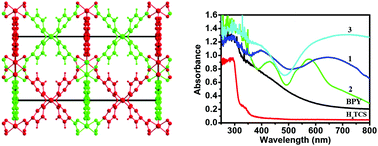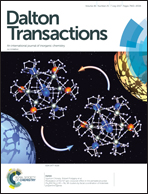Theoretical and experimental studies on three water-stable, isostructural, paddlewheel based semiconducting metal–organic frameworks†
Abstract
Three water-stable isostructural metal–organic frameworks (MOFs) of the general formula [M2(TCS)(BPY)] (M = Co(1), Ni(2) and Cu(3); H4TCS = tetrakis(4-carboxyphenyl) silane, BPY = 4,4′-bipyridine) were synthesized and fully characterized. MOFs 1–3 are stable in pH = 5–11, 2–11, 3–11 aqueous solution respectively for at least 24 h at room temperature. Although H4TCS absorbs only UV light, MOFs 1–3 absorb both UV and visible light in broad ranges (250–800 nm) and absorb more visible light than the ligand BPY. The rapid anodic photocurrent responses of MOFs 1–3 under UV and visible light illumination were observed. The photocurrent densities increase in the order of MOF 3 < 1 < 2 under visible light illumination (430 nm). The band gaps of MOFs 1–3 determined based on UV-Vis diffuse reflectance spectra and electrochemical (EC) analysis are 1.28, 1.35 and 0.67 eV, respectively. MOF 1 is able to photocatalyze the reduction of CO2 to CH4 under visible light, producing CH4 (1.44 μmol g−1 in 8 h), which is unprecedented in MOFs. The catalytic activity of MOF 1 (0.75 μmol g−1 after 4 h) under the irradiation of a 300 W xenon lamp is significantly better than those of MOFs 2 and 3 (0.14 μmol g−1 after 4 h). The band structures, density of states and band gaps of MOFs 1–3 were calculated by the GGA-PBE and GGA-PBE+U method implemented in VASP code. The calculations show that all the three compounds can be viewed as bulk intermediate band (IB) materials. The density of states of the IB in MOF 1 is high, which could suppress the non-radiative recombination. The density of states of the IB levels in MOFs 2 and 3 are low, making these levels very effective recombination centres, thus jeopardizing the photocatalytic activities of MOFs 2 and 3. The calculated results are in good agreement with experimental results and explain the photocatalytic activity differences. This study is the first to successfully address the question of how the types of unpaired electron containing electron-rich metal ions (i.e. Cu(II), Co(II), Ni(II)) affect the band gaps and band structures of MOFs and thus their photoelectronic properties.



 Please wait while we load your content...
Please wait while we load your content...